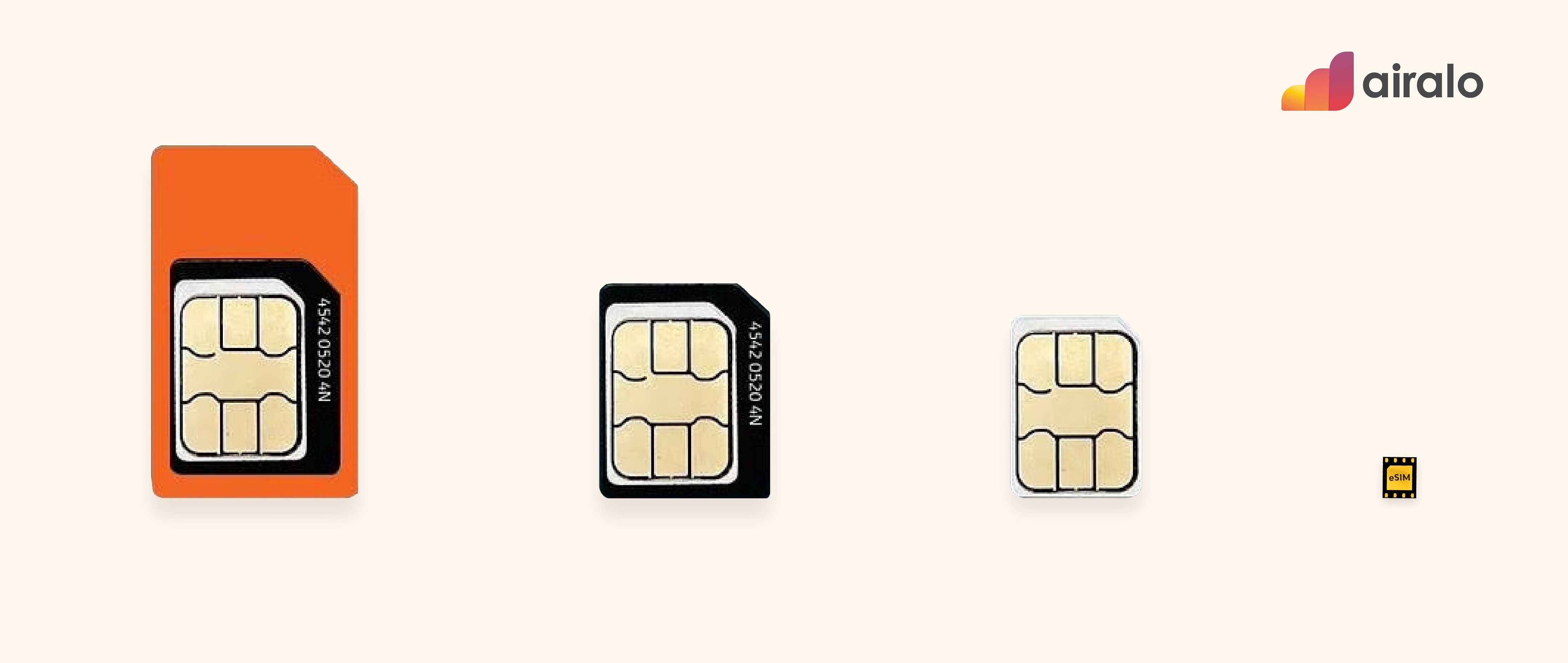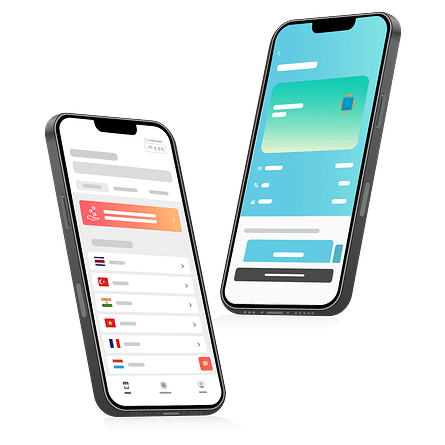
There are plenty of mysterious terms related to mobile phones, connectivity, and cellular devices. Here, we break down the most common tech terms you'll encounter and what they actually mean (without the technical jargon!).
You'll find the answers to all your questions, including:
- What is a SIM card?
- What is Dual SIM?
- What is an eSIM?
- What is an app?
- What is a network?
- What is mobile data?
- What is data roaming?
- What is the difference between 3G, LTE, and 5G?
- What is a hotspot?
- What is local storage?
- What is an ICCID?
- What is an APN?
- What is VoIP?
- What is Mbps?
- What is Data Saver mode?
What Is a SIM Card?
SIM stands for "subscriber identity module." SIM cards are tiny memory chips that store information about you as a mobile customer and give you access to a carrier's network, allowing you to call, text, and access data. You can think of a SIM card as a two-step verification for your carrier: They identify you as a customer and verify if your SIM is compatible with their network(s).
What Is Dual SIM?
Dual SIM refers to a mobile phone or device that can house more than one SIM and/or eSIM at a given time. This gives your phone the built-in ability to connect to two different networks simultaneously. A few ways to use Dual SIM technology include:
- Add a local data plan when you travel
- Use one plan for voice and another for data
- Keep separate business and personal numbers on the same phone
What Is an eSIM
eSIM stands for "embedded subscriber identity module." It's a tiny memory chip that's built into your device, eliminating the need to remove a physical SIM to connect to a carrier. Instead, you can easily and affordably download a cellular plan and connect to a new network within minutes.
With an Airalo eSIM, you can:
- Download a data plan and be up and running within minutes
- Continue to use your primary number for calls and text messages while using your eSIM for data and internet
- Store multiple eSIMs on your phone, making switching between plans a breeze
- Avoid daily roaming charges from your mobile provider
- Easily switch between local, regional, or global data plans
- Eliminate the need to find a SIM vendor while traveling

What Is an App?
App is short for "application." Applications are programs downloaded directly to your phone or mobile device. The term is interchangeable with programs or software but has been commonly used in relation to mobile devices.
What Is a Network?
A cellular network is a series of service towers that enable you to connect to a carrier's mobile network and make calls, send texts, and access data. Different carriers own, operate, and outsource connectivity to various providers. You can think of a cellular network as owning different ports in a city. The owner of the port decides who has access to the service and at what cost. When your network is not within the owner's service range, you're granted access but charged a premium (known as roaming).
What Is Mobile Data?
Mobile data (also called cellular data) is internet data that's transferred through a cellular network rather than a traditional fiber, cable, or DSL connection. When you connect to the internet without Wi-Fi, you're using mobile data.
What Is Data Roaming?
Data roaming is when you use a foreign wireless/cellular provider's network to access your smartphone services abroad. You start roaming as soon as you travel outside your home network. When you roam, you operate as a guest of a new network, and call, text, and data services get charged at a different (typically higher) rate. Daily roaming charges can be pricey — here's a closer look at how they add up (and how to avoid them).

What Is the Difference Between 3G, LTE, and 5G?
3G (3rd generation networks) refer to the common name of cellular towers that offer 2mbps for stationary activity and 384kbps when on the move (like a vehicle). They're relatively common among networks already in place but are becoming more outdated as new generations replace them.
LTE (long-term evolution networks) are the successor to 3G networks. They're, on average, 500X faster than 3G networks, offering 10-100Mbps download speeds. Introduced in the late 2000s, their exponential difference in speed has slowly become standard across most global coverage areas.
5G (5th generation networks) are the successor to 4G networks. With their low latency and high bandwidth, they're far faster than 4G. This could mean streaming videos in 4K, downloading huge files, and/or sharing information at record speeds.
What Is a Hotspot?
A hotspot is a physical location (like a library, cafe, airport, or hotel) where people can connect to the internet, typically using Wi-Fi. Some mobile devices, like smartphones and tablets, can act as hotspots by sharing their cellular data connection with other devices.

What Is Local Storage?
Local storage is information that is stored directly on your device. This includes apps, photos, music, and more that take up space on your phone. Local storage can be managed directly in your settings.
What Is an ICCID?
An ICCID (Integrated Circuit Card Identifier) is an 18- to 22-character code that identifies a SIM card. It includes information about a SIM's country, home network, and identification number. No SIM card has the same ICCID.
What Is an APN?
An APN (Access Point Name) is a gateway between a cellular network and the internet. It's composed of a network identifier and an operator identifier and provides the details your device needs to connect to your carrier's network.

What Is VoIP?
VoIP stands for "voice over internet protocol." VoIP allows you to place and receive calls over the internet rather than a traditional phone line. In the 1990s, when dial-up modems were commonplace, VoIPs presented a way to connect without using a landline. Today, apps like Facebook Messenger and WhatsApp use VoIP to allow you to make calls over the internet. They're often used for business calls, personal calls, and general audio/video communication.
What Is Mbps?
Mbps stands for "megabytes per second." It describes the bitrate (or speed) of uploading and downloading data. Mbps is the most common bitrate measurement as most data does not transfer at a kilobyte, gigabyte, or terabyte rate. Gbps and Tbps might become common terms in the next few years.
What Is Data Saver Mode?
Data Saver mode is an Android feature that limits the amount of data apps can use when you aren't connected to Wi-Fi. When it's switched on, it prevents any apps running in the background from connecting to the internet.
From bitrates to eSIMs, you're now equipped with the latest lingo to discuss your phone or mobile device. Dive into our latest blog posts to keep learning!


